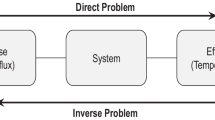Abstract
This special issue was initiated by the priority programme 1480 “Modelling, simulation and compensation of thermal effects for complex machining processes” and presents current investigations, new approaches and relevant results with regard to the specific topic. In addition to the contributions from the priority programme, this issue contains selected publications, which complement the substantial overview of novel developments in the area of heat source identification, modelling, simulation, minimisation and compensation of thermal effects in machining operations.
Similar content being viewed by others
Avoid common mistakes on your manuscript.
1 Motivation
In almost all machining operations the workpiece is thermally affected. The thermal energy generated by the cutting process results mainly from the high-speed material shearing within the chip formation zone (primary shear zone) and from friction between the chip, the tool and the workpiece (secondary and tertiary shear zone). This cutting energy is dispersed into the workpiece, the chip, the cutting tool and the surrounding medium. In dry cutting and machining with minimum quantity lubrication (MQL), the cooling aspect of the surrounding medium does not exist or it is at least dramatically reduced due to the low thermal conductance of air. Nevertheless, the use of MQL can reduce the fraction of the heat generated by friction. The heat accumulated during the manufacturing process induces a transient temperature field in the workpiece and causes a considerable distortion of the machined part. Therefore, an insufficient dimensional, shape and position accuracy results and the finished part exhibits tolerance violations. Numerous dry and MQL processes induce complex thermomechanical loads, which can lead not only to thermally caused shape deviations, but also to an insufficient surface integrity due to microstructure changes or phase transformations (Fig. 1). Furthermore, the thermal influencing of the workpiece can cause a production-based impairment in the future product life cycle. Currently, extensive trials and run-in experiments have to be performed by the manufacturing industry in order to determine the major influencing factors and design reliable machining processes.
2 Objectives and methods
The primary objective of the priority programme 1480 is the compensation of thermally induced effects affecting the machined component (Fig. 1). Therefore, the main aim is to develop predictive, simulation-based strategies for the minimisation of the resulting thermal workpiece distortion and subsurface damage. This procedure should enable the prediction of relevant workpiece characteristics and the design of cutting processes during the planning phase of new components and products without the multiplicity of “trial and error” tests resulting in defective parts and rejects (Fig. 2). As an example, simulation approaches based on the finite element method are often considered to be appropriate for this purpose, as they are capable of representing the thermomechanical behavior of complex components under consideration of the loads, resulting from the machining process.
Within the framework of the priority programme 1480, 22 institutes from the area of production engineering, mechanics, mathematics, thermodynamics and material sciences collaborate in an inderdisciplinary network. 12 research projects focus on relevant cutting processes—turning, (deep-hole) drilling, milling and hobbing—as well as abrasive processes. Due to the high potential for reducing the coolant-related energy consumption, the cutting processes are analysed using dry machining or where appropriate—MQL. The spectrum of examined components is comprised of geometrically complex shapes with homogeneous workpiece material and components with inhomogeneous material structure. Three working groups, focusing on measurement technology, modelling and simulation techniques as well as on material and friction modelling, stimulate the interdisciplinary exchange within the priority programme. Three stages with a term of 2 years each were defined in order to enable a structured proceeding in achieving the main objectives of the programme. The first stage “feasibility” was carried out in the years 2011 and 2012 and contains fundamental investigations on the determination of the process heat source as well as the initial modelling and simulation of its impact on the workpiece. Within the second project stage called “flexibility” two further years were used to enhance the models and consider complex part shapes as well as multiple heat sources, where necessary. The third stage entitled “compensation” started in the beginning of 2015. Thereby, the simulation approaches and models developed in the first two phases are used for the prediction of thermal distortion and subsurface damage caused by the machining process. Based on validated results the development of appropriate compensation strategies, such as NC-correction of the tool path, constitutes the key focus of the third and last stage of the programme (Fig. 2).
Acknowledgments
The priority programme 1480 “Modelling, simulation and compensation of thermal effects for complex machining processes” has been funded by the German Research Foundation (Deutsche Forschungsgemeinschaft—DFG). The spokesperson Prof. Dr. Dirk Biermann kindly appreciates the support of this research on behalf of all members of the priority programme 1480.
Author information
Authors and Affiliations
Corresponding author
Rights and permissions
About this article
Cite this article
Biermann, D., Iovkov, I. Modelling, simulation and compensation of thermal effects for complex machining processes. Prod. Eng. Res. Devel. 9, 433–435 (2015). https://doi.org/10.1007/s11740-015-0634-7
Received:
Accepted:
Published:
Issue Date:
DOI: https://doi.org/10.1007/s11740-015-0634-7






